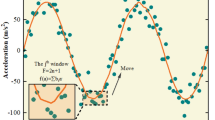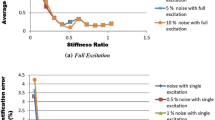Abstract
In order to improve the screening efficiency of vibrating screen and make vibration process smooth, a new type of magnetorheological (MR) damper was proposed. The signals of displacement in the vibration process during the test were collected. The trispectrum model of autoregressive (AR) time series was built and the correlation dimension was used to quantify the fractal characteristics during the vibration process. The result shows that, in different working conditions, trispectrum slices are applied to obtaining the information of non-Gaussian, nonlinear amplitude-frequency characteristics of the signal. Besides, there is correlation between the correlation dimension of vibration signal and trispectrum slices, which is very important to select the optimum working parameters of the MR damper and vibrating screen. And in the experimental conditions, it is found that when the working current of MR damper is 2 A and the rotation speed of vibration motor is 800 r/min, the vibration screen reaches its maximum screening efficiency.
Similar content being viewed by others
References
SOHAMED J, CETTEY A, MARWALA N. A magnetorheological actuation system: Test and model [J]. Smart Material and Structure, 2008, 17: 1–15.
YING Z G, NI Y Q, KO J. Semi-active optimal control of linearized systems with multidegree of freedom and application [J]. Journal of Sound and Vibration, 2005, 279(1/2): 373–388.
YANG G Q. Large-scale magnetorheological fluid damper for vibration mitigation: Modeling, testing and control [D]. Indiana: University of Notre Dame, 2001.
XIA Pin-qi. An inverse model of MR damper using optimal neural network and system identification [J]. Journal of Sound and Vibration, 2003, 266(5): 1009–1023.
KORDONSKI W I, SHOREY A B. Magnetorheological (MR) jet finishing technology [J]. Journal of International Material Systems and Structures, 2007, 18(12): 1127–1130.
YARWALA D S, RILAKAZI B. Noise and vibration reduction of a vibrating screen [C]// 2005 SME Annual Meeting. Got Mining Preprints: SAM, 2005: 519–531.
SCHURTER K C, ROSCHKE P N. Fuzzy modeling of a magnetorheological damper using ANFIS [C]// The 9th IEEE International Conference on Meeting. Xiamen, China: FUZZ IEEE, 2000: 122–127.
BERGER B S, BETAI C, ANAND D K. time series analysis with auto regressive SVD algorithms [C]// The 37th Heat Transfer and Fluid Mechanics Institute. Sacramento: CSUS, 2001: 1–13.
KYUNG J, JONGWON S, BYUNG M. A behavioral model of axisymmetrically configured magnetorheological fluid using Lekner summation [J]. Journal of Applied Physics, 2009, 105(7): 1–3.
BALAN C, DIANA B, GHEORGHIU E. Rheological characterization of complex fluids in electro-magnetic fields [J]. Non-Newtonian Fluid Mech, 2008, 154: 22–30.
YANG Shu-zi, WU Ya. Time series analysis in engineering application [M]. Wuhan: Huazhong University of Science and Technology Press, 2007: 181–187. (in Chinese)
KHASHABA U A, SELMY A I. Prediction of surface roughness profiles for milled surfaces using an artificial neural network and fractal geometry approach [J]. Journal of Materials Processing Technology, 2008, 200(3): 271–278.
ODIBAT Z, MOMANI S. Numerical methods for nonlinear partial differential equations of fractional order [J]. Applied Mathematical Modelling, 2008, 32(1): 28–39.
DAVIS G B, KOHANDEL M. The constitutive properties of the brain paraenchyma. Part 2. Fractional derivative approach [J]. Medical Engineering and Physics, 2006, 28(5): 455–459.
CHEN Bing-san, HUANG Yi-jian. Autoregressive trispectrum and its slices analysis of magnetorheological damping device [J]. Journal of Central South University of Technology, 2008, 15(s1): 247–251.
Author information
Authors and Affiliations
Corresponding author
Additional information
Foundation item: Project(50975098) supported by the National Natural Science Foundation of China; Project(2008HZ0002-1) supported by the Major Scientific and Technological Program of Fujian Province, China
Rights and permissions
About this article
Cite this article
Wu, Fs., Huang, Yj., Huang, K. et al. Trispectrum and correlation dimension analysis of magnetorheological damper in vibration screen. J. Cent. South Univ. 19, 1832–1838 (2012). https://doi.org/10.1007/s11771-012-1216-x
Received:
Accepted:
Published:
Issue Date:
DOI: https://doi.org/10.1007/s11771-012-1216-x




